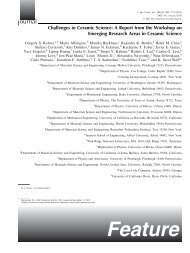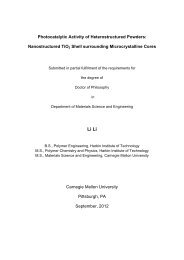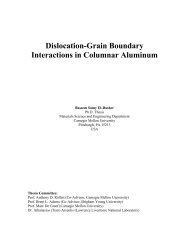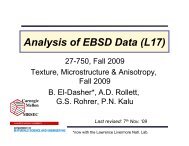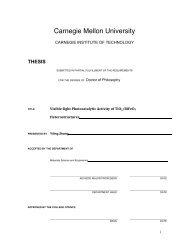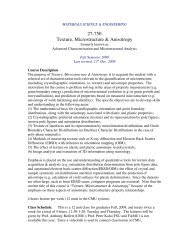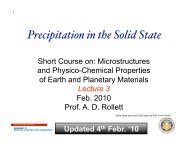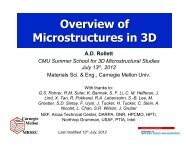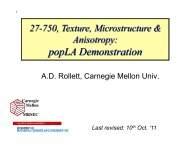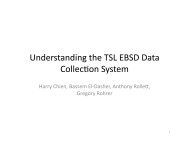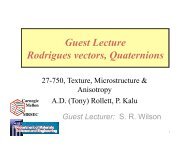¶ 3. Mathematical Representation of Crystal Orientation, Misorientation
¶ 3. Mathematical Representation of Crystal Orientation, Misorientation
¶ 3. Mathematical Representation of Crystal Orientation, Misorientation
You also want an ePaper? Increase the reach of your titles
YUMPU automatically turns print PDFs into web optimized ePapers that Google loves.
<strong>3.</strong>F Quaternions<br />
A close cousin to the Rodrigues vector is the quaternion. An excellent description <strong>of</strong><br />
quaternions, their history and properties can be found in Altmann’s book. They have also<br />
been much used in robotics for describing rotations. It is defined as a four component<br />
vector in relation to the axis-angle representation as follows, where [uvw] are the<br />
components <strong>of</strong> the unit vector representing the rotation axis, and θ is the rotation angle.<br />
q = q(q1,q2,q3,q4) = q( u sinθ/2, v sinθ/2, w sinθ/2, cosθ/2) (<strong>3.</strong>F.1)<br />
Note that many authors put the fourth component in the first position, i.e.<br />
q = ( cosθ/2, u. sinθ/2, v sinθ/2, w sinθ/2). This set <strong>of</strong> components was obtained by<br />
Rodrigues prior to Hamilton’s invention <strong>of</strong> quaternions and their algebra. Some authors<br />
refer to the Euler-Rodrigues parameters for rotations in the notation (λ,Λ) where λ is<br />
equivalent to q4 and Λ is equivalent to the vector (q1,q2,q3). The particular form <strong>of</strong> the<br />
quaternion that we are interested in has a unit norm (√{q1 2 +q2 2 +q3 2 + q4 2 }=1) but<br />
quaternions in general may have arbitrary “length”. Yet another notation writes the unit<br />
quaternion q is an ordered set <strong>of</strong> four real numbers <strong>of</strong> the following form,<br />
3<br />
2<br />
q = (q0 ;q) = (q0 ;q1 ;q2 ;q3 ), satisfying ∑ qi =1. (<strong>3.</strong>F.2)<br />
The quaternion q = { q0<br />
, −q<br />
} is associated with the inverse rotation,<br />
€<br />
<strong>3.</strong>F.1 Conversions<br />
i= 0<br />
−1<br />
g .<br />
If one has the rotation in (orthogonal) matrix form (g or a), it can be converted to a<br />
quaternion via the following formulae.<br />
ε ijk Δg jk<br />
qi = ±<br />
4 1+ tr Δg<br />
⎛ q ⎞ ⎡<br />
1 sinθ<br />
⎜ ⎟ 2<br />
[a(2,3) − a(3,2)]/ norm<br />
⎤ ⎡<br />
⎢<br />
⎥ ±[Δg(2,3) − Δg(3,2)]/2 1+ tr( Δg)<br />
⎤<br />
⎢<br />
⎥<br />
⎜ q2⎟ ⎢ sinθ<br />
⎜ ⎟ =<br />
2<br />
[a(1,3) − a(3,1)]/ norm ⎥<br />
⎢<br />
⎥<br />
⎢ ±[Δg(3,1) − Δg(1,3)]/2 1+ tr( Δg)<br />
⎥<br />
⎜ q €<br />
=<br />
3⎟<br />
⎢ sinθ<br />
⎜<br />
⎝ q<br />
⎟<br />
2<br />
[a(1,2) − a(2,1)]/ norm ⎥ ⎢<br />
⎥ (<strong>3.</strong>F.3)<br />
±[Δg(1,2) − Δg(2,1)]/2 1+ tr Δg<br />
⎢<br />
⎥ ⎢<br />
( ) ⎥<br />
4⎠<br />
⎣ ⎢ cosθ<br />
2 ⎦ ⎥<br />
⎣<br />
⎢ ± 1+ tr( Δg)<br />
/2 ⎦<br />
⎥<br />
( ) (<strong>3.</strong>F.3)<br />
norm = [ a(2,3) − a(3,2) ]<br />
€<br />
2 + [ a(1,3) − a(3,1) ] 2 + [ a(1,2) − a(2,1) ] 2 (<strong>3.</strong>F.4)<br />
cos θ 2 = 1 2<br />
1+ tr( a)<br />
(<strong>3.</strong>F.5)<br />
8/27/09 16



